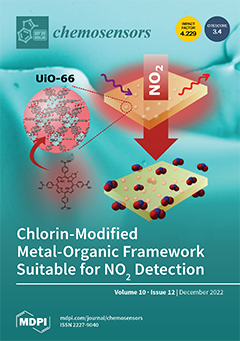A comparative analysis of the chemiresistive sensor response of thin films of a series of tetrasubstituted phthalocyanines of various metals with F-substituent in peripheral (MPcF
4-p, M = Cu, Co, Zn, Pb, VO) and non-peripheral (MPcF
4-np) positions in macroring to
[...] Read more.
A comparative analysis of the chemiresistive sensor response of thin films of a series of tetrasubstituted phthalocyanines of various metals with F-substituent in peripheral (MPcF
4-p, M = Cu, Co, Zn, Pb, VO) and non-peripheral (MPcF
4-np) positions in macroring to low concentrations of ammonia (1–50 ppm) was carried out. It was found that MPcF
4-p films exhibit a higher sensor response than MPcF
4-np ones. A CoPcF
4-p film demonstrated a calculated LOD of 0.01 ppm with a recovery time of 215 s, while a VOPcF
4-p film had LOD of 0.04 ppm and the recovery time of 270 s. The selectivity test showed that CO
2, ethanol, acetone, benzene, and formaldehyde did not interfere with the determination of ammonia, while H
2S at a concentration of more than 10 ppm could act as an interfering gas. It was shown that, as a result of quantum-chemical calculations, the observed regularities are best described by the interaction of NH
3 with phthalocyanines through the formation of hydrogen bonds between NH
3 and side atoms of the macroring. In the case of MPcF
4-p, the NH
3 molecule approaches the macrocycle more closely and binds more strongly than in the case of MPcF
4-np. The stronger binding leads to a stronger effect of the ammonia molecule on the electronic structure of phthalocyanine and, as a consequence, on the chemiresistive sensor response of the films to ammonia.
Full article





